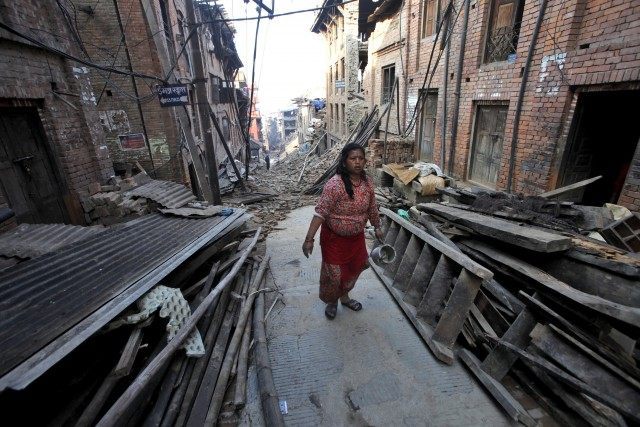CHARIKOT, Nepal (AP) — Nepal has been overwhelmed by its second massive earthquake in less than three weeks, its prime minister said Thursday as he visited this normally placid foothills town, now a center for frightened villagers desperate for government help.
Thousands of people now crowd the streets of Charikot, the administrative center of the isolated district hit hardest by Tuesday’s magnitude-7.3 quake, which killed at least 96 people and injured more than 2,300. The magnitude-7.8 earthquake that hit April 25 killed more than 8,150 people, injured tens of thousands more and left hundreds of thousands homeless.
“After the first quake, we were not prepared for a second one so big,” Prime Minister Sushil Koirala told reporters after arriving in Charikot by helicopter.
He said the coming monsoon rains now loomed large, with hundreds of thousands of people left homeless.
“We need tents. Our people need shelter. With the rainy season, it will be difficult for people to survive in the open,” he said.
Nearly everyone is too afraid to sleep indoors in Charikot, which is filling with people from surrounding areas seeking help. Dozens of smaller aftershocks terrorize the country.
While there have been occasional food handouts here, there was nowhere near enough supplies distributed for the people who kept arriving. Many people simply waited at the locked gates of the army’s small aid distribution center, shaking the fence angrily when their frustration got the better of them.
“We came here with such hopes and such difficulty, but now we’re just waiting and waiting,” said Navraj Nama, 25, who came to Charikot with his brother and elderly uncle after the second earthquake. He said 90 percent of their home village, Danda Khorka, had been damaged in the April 25 quake, and about 50 buildings had collapsed when the second one hit.
Nama’s village is among those in desperate need of shelter, and the young farmer came here hoping to get tents or tarpaulins to carry back with him. But none were available.
There is also a shortage of tarps and tents in the Nepalese capital, Kathmandu, with some people even using cardboard boxes as temporary shelters.
“We have nowhere to go. This is our home for now. We had just moved back into our rented rooms and again the earthquakes are back,” Raj Kumar, a carpenter who was sharing a small tent with two other families, said in Kathmandu.
Earlier, army teams using power drills, saws and their bare hands unearthed the body of a woman killed in Charikot on Tuesday when a building collapsed around her. The smell was overwhelming as they pulled out the body. Soldiers quickly sprayed the rubble with a strong disinfectant.
A search continued Thursday for a U.S. Marine helicopter carrying six Marines and two Nepalese soldiers. It disappeared Tuesday while delivering aid in the country’s northeast, U.S. officials said.
Col. Steve Warren, a Pentagon spokesman, said Wednesday that the U.S. aerial search for the Marine helicopter had found “nothing of note.”
He said that in addition to U.S. aircraft, the U.S. has redirected some satellites to assist in the search. Officials in Kathmandu said the search was focused on the Sunkhani area, nearly 80 kilometers (50 miles) northeast of the capital.
The Tuesday quake, while strong, was significantly less powerful than the first one, and the most severe shaking occurred over a much smaller area. It was centered between Kathmandu and Mount Everest, and was southeast of last month’s earthquake. It hit hardest in deeply rural parts of the Himalayan foothills, hammering many villages reached only by hiking trails and causing road-blocking landslides.
“Damaged houses were further damaged or destroyed. Houses and school buildings spared before were affected … roads were damaged,” said Jamie McGoldrick, a top U.N. official in Nepal.
___
AP writers Binaj Gurubacharya in Kathmandu, Tim Sullivan in New Delhi and Robert Burns in Washington contributed to this report.

COMMENTS
Please let us know if you're having issues with commenting.